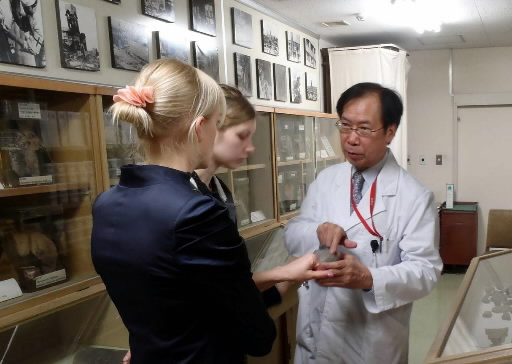HICARE focused on developing human resources for radiation exposure accidents
Apr. 22, 2014
The Hiroshima International Council for Health Care of the Radiation-exposed (HICARE, based in Naka Ward, Hiroshima) is an organization which shares research and expertise on medical treatment for A-bomb survivors and the health effects caused by exposure to radiation. This information is made available to medical institutions, health care professionals, and research organizations in and out of Japan. HICARE was founded in 1991 by the City of Hiroshima and Hiroshima Prefecture, in cooperation with the Radiation Effects Research Foundation (RERF).
HICARE was established after the accident at the Chernobyl nuclear power plant in 1986. Following this disaster, institutions in Hiroshima and Nagasaki were contacted for support because of their experience and knowledge involving the treatment of A-bomb survivors. Medical professionals in the former Soviet Union visited Hiroshima University and RERF to undergo training and take advantage of their expertise. In order to assist with this information exchange, the governments of Hiroshima City and Hiroshima Prefecture, along with other concerned entities, created a kind of consulting service, which then became HICARE.
HICARE’s activities include dispatching doctors to needed areas and providing training for physicians from overseas. Since its establishment to the end of March 2013, HICARE has dispatched 189 medical professionals to Korea, Kazkhstan, and Fukushima. During this same period, they have provided training for 388 participants. (And if partial training requested by other organizations is included, the total is 1,305.) In 2010, HICARE signed a memorandum with the International Atomic Energy Agency (IAEA) and has expanded the breadth of its international efforts by dispatching lecturers to IAEA trainings and engaging in joint research.
In addition, HICARE published a medical handbook for the treatment of A-bomb survivors in 1992, titled “The Effects of A-bomb Radiation on the Human Body.” A revised second edition was published in 2012, which includes the latest research findings. Currently, the organization is focused on developing human resources, such as doctors and nurses who can provide medical treatment in the event of radiation exposure at medical sites or disasters like the accident at the nuclear power plant in Fukushima Prefecture.
Kazuhiro Iwasaki, 53, a HICARE official, said, “Our research has involved looking at the deaths of many people, so we mustn’t forget that our work is based on their sacrifice.”
It’s important, I think, to see that some good for the future can come from even terrible damage. (Shino Taniguchi, 15)
(Originally published on April 7, 2014)
HICARE was established after the accident at the Chernobyl nuclear power plant in 1986. Following this disaster, institutions in Hiroshima and Nagasaki were contacted for support because of their experience and knowledge involving the treatment of A-bomb survivors. Medical professionals in the former Soviet Union visited Hiroshima University and RERF to undergo training and take advantage of their expertise. In order to assist with this information exchange, the governments of Hiroshima City and Hiroshima Prefecture, along with other concerned entities, created a kind of consulting service, which then became HICARE.
HICARE’s activities include dispatching doctors to needed areas and providing training for physicians from overseas. Since its establishment to the end of March 2013, HICARE has dispatched 189 medical professionals to Korea, Kazkhstan, and Fukushima. During this same period, they have provided training for 388 participants. (And if partial training requested by other organizations is included, the total is 1,305.) In 2010, HICARE signed a memorandum with the International Atomic Energy Agency (IAEA) and has expanded the breadth of its international efforts by dispatching lecturers to IAEA trainings and engaging in joint research.
In addition, HICARE published a medical handbook for the treatment of A-bomb survivors in 1992, titled “The Effects of A-bomb Radiation on the Human Body.” A revised second edition was published in 2012, which includes the latest research findings. Currently, the organization is focused on developing human resources, such as doctors and nurses who can provide medical treatment in the event of radiation exposure at medical sites or disasters like the accident at the nuclear power plant in Fukushima Prefecture.
Kazuhiro Iwasaki, 53, a HICARE official, said, “Our research has involved looking at the deaths of many people, so we mustn’t forget that our work is based on their sacrifice.”
It’s important, I think, to see that some good for the future can come from even terrible damage. (Shino Taniguchi, 15)
(Originally published on April 7, 2014)








